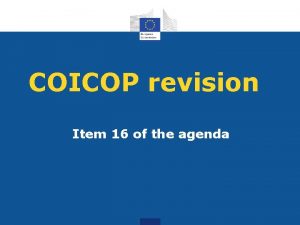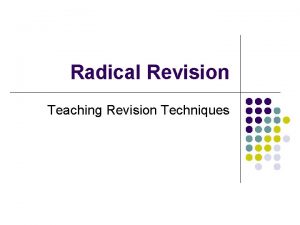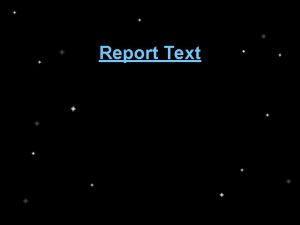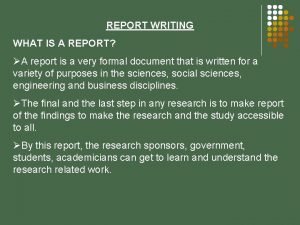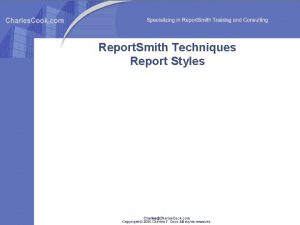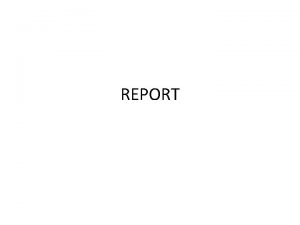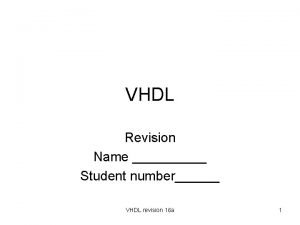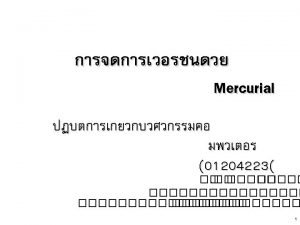COICOP revision Report from the TSGCOICOP COICOP revision





















- Slides: 21

COICOP revision Report from the TSG-COICOP

COICOP revision history – 1 st phase (2011 -2013) Ø UN Expert Group on International Classifications (EG) discussed the possibility of revising COICOP for the first time in 2011 Ø Bad timing: SNA has just been revised and a revision of COICOP could disturb SNA implementation Ø Essential to assess first the need and scope of this revision Ø UNSD run a global survey to find out what were the main aspects of COICOP that were considered outdated by the Countries

COICOP revision history – 1 st Global consultation Results: - countries were generally in favour of an update or revision of COICOP, - revision is needed to reflect the significant changes in goods and services in some areas: for example, new products had emerged in some areas of household consumption (mainly in Divisions 08 and 09), while some products had disappeared from the market. - more detailed guidelines to ensure a proper and correct recording. - the introduction of a fifth digit level was also supported by a majority of countries. When : between October and December 2012 Who : 68 countries and 4 international organisations

COICOP revision history – 2 nd phase (2013 -2015) Ø The results from the global consultation were presented and discussed during the UN Expert Group meeting in 2013 Ø A new Technical Subgroup was set up Ø Mandate: solve issues raised during the 1 st global consultation by caselaws + evaluate if the unsolved issues were sufficiently important to justify a revision Ø The TSG-COICOP identified three main groups of issues raised during the first global consultation: Ø issues which would imply a change in COICOP, Ø issues which could be solved by case laws but ideally by a change in structure and Ø issues which could be solved just by case laws.

COICOP revision history – 2 nd phase (2013 -2015) Ø The TSG-COICOP prepared clarifications on 33 issues and presented its report at the EG meeting in 2015 Ø And recommended launching a full revision of the COICOP classification as there were enough and sufficiently relevant requests for change. Ø Concerning the other purpose classifications in the SNA, it was decided that the COICOP should be revised first and that an impact assessment on COFOG, COPNI and COPP should be conducted after. Ø The revision of COICOP was officially launched

TSG-COICOP Kate Alice Cindia Aimee Herman ISWGNA Norbert Vera Alexander Veronica Andrew Francette ISWGPS Valentina Ralf Valentina Carsten Gabriela

COICOP revision history – 3 rd phase (2016 -2017) Ø In March 2016 the TSG-COICOP met in Geneva and drafted a first proposal for a new revised structure of COICOP using the proposals raised during the first global consultation as a starting point. Ø The new proposal introduced an additional level of detail that would better serve the various uses of COICOP in different statistical domains. Ø Goods and services were systematically separated as much as possible.

COICOP revision history – 2 nd Global consultation Results: - 64% of overall agreement on the proposed COICOP with less than 50% of agreement on divisions 01 (Food and beverages) and 06 (Health) - Level of detail considered adequate except for division 01 and 06 that were considered too detailed. - The terminology of most divisions was regarded to be easily understandable by the average household. Only division 06 (Health) had a lower average. - More than 500 useful and constructive comments that covered all type of issues related with the proposal of revision When : between September and November 2016 Who : 93 countries and 13 international organisations

COICOP revision history – 3 rd phase (2016 -2017) Ø Based on the feedback received , the TSG-COICOP met a second time in April 2017, in New York and updated the draft classification. Ø The TSG-COICOP analysed all issues raised during the global consultation and provide answers to each of them (annex 4) Ø For more information on the COICOP Revision process, please visit the COICOP revision webpage https: //unstats. un. org/unsd/class/revisions/coicop_revision. asp

COICOP revision timeline

Next steps • After discussion of the present draft of the COICOP 2018 in the EG on International Statistical Classifications and update based on the feedback received, the COICOP 2018 will be presented to the 49 th Session of the Statistical Commission (March 2018) for endorsement.

Documents prepared by the TSGCOICOP Ø Introductory guidelines to the COICOP 2018 – Annex 1 Ø COICOP 2018 structure and explanatory notes – Annex 2 Ø Correspondence table between COICOP 2018 – COICOP 1999 – Annex 3 Ø Answers to the comments received during the Global consultation on the revision of COICOP – Annex 4

Major changes introduced in COICOP – more detail Ø The new COICOP introduces a 4 th level denominated subgroup (5 digits) because: Ø Most of the National Statistical offices collect already more detailed data. Ø It makes correspondence to CPC easier. Ø It facilitates the separation between goods and services without introducing major breaks in the time series. Ø Most countries answering the first global consultation were in favour of adding a 5 th digit Ø Some regional classifications (like ECOICOP for the European Union countries and PACCOICOP 2012 developed by the Secretariat for the Pacific Community) have already a 5 th digit remaining fully consistent with the UN COICOP.

Major changes introduced in COICOP – more detail Ø An expansion at six digits for Division 01, fully consistent with the 5 digits classification, is provided as an official Annex to the COICOP because: Ø The consumption on food and beverages in the household consumption is very important (from 21% of the total household consumption to 54% among the World countries) and it was considered important to have more detailed information on this area.

Major changes introduced in COICOP – better correspondence with other classifications Division 06 Health COICOP Division 10 Education ISCED ICHA CPC

Major changes introduced in COICOP – Separation between goods and services Ø The new COICOP includes the distinction between goods and services whenever this is possible and new classes or sub-classes were created systematically for services like repair, maintenance, installation or renting of goods. Ø However this separation is not always possible: Ø Restaurant services, reparations, inpatient care services : goods and service are often charged together Ø On-line services: products like downloads of music and books in a technical perspective could be viewed as a service, but serve the same purpose as products traditionally viewed as goods Ø Bundles of goods and services (telecommunication bundles)

Major changes introduced in COICOP – Classification by durability Ø A majority of countries supports the distinction of goods in Durable, Semi-Durable and Non-Durable and Services for analytical purposes. Ø The distinction was made at the level of classes and sub-classes.

Major changes introduced in COICOP – Changes at division level Ø The highest level of the classification remained unchanged for most of the Divisions to avoid breaks in the time-series. Ø Division 08 and 09 were considerably reorganised and now break down as Information and communication (Division 08) and Recreation, sport and culture (Division 09). Ø Division 07 Transport that previously was dedicated to the transport of individuals includes now the transport of goods also Ø Division 12 was split into 2 divisions: Ø Division 12 Insurance and financial services Ø Division 13 Personal care, social protection and miscellaneous goods and services

Major changes introduced in COICOP – Modernization Ø The list of inclusions and exclusions of all classes was carefully revised to include goods and services that didn't exist when the previous version of the classification was drafted. Ø Products that do not exist anymore in the market were also excluded from the list of inclusions.

Issues to be discussed Ø Feedback on the documents proposed Ø Plastic surgery: should it be classified in Division 06 Health or in Division 13 under Personal care? Ø Shall Division 10 cover also non-formal education? Ø Where to classify GPS? Ø How the coordination of different existing alphabetical indexes could be used as a source for the elaboration of the COICOP 2018 index? Ø Is there a need for revision or update of the other functional classifications (COFOG, COPP, and COPNI)?

• Thank you for your attention
 Passive revision
Passive revision Từ ngữ thể hiện lòng nhân hậu
Từ ngữ thể hiện lòng nhân hậu Tư thế ngồi viết
Tư thế ngồi viết Trời xanh đây là của chúng ta thể thơ
Trời xanh đây là của chúng ta thể thơ Thế nào là giọng cùng tên
Thế nào là giọng cùng tên Chó sói
Chó sói Thơ thất ngôn tứ tuyệt đường luật
Thơ thất ngôn tứ tuyệt đường luật Khi nào hổ con có thể sống độc lập
Khi nào hổ con có thể sống độc lập đại từ thay thế
đại từ thay thế Thế nào là hệ số cao nhất
Thế nào là hệ số cao nhất Diễn thế sinh thái là
Diễn thế sinh thái là Vẽ hình chiếu vuông góc của vật thể sau
Vẽ hình chiếu vuông góc của vật thể sau Frameset trong html5
Frameset trong html5 Thế nào là mạng điện lắp đặt kiểu nổi
Thế nào là mạng điện lắp đặt kiểu nổi Mật thư tọa độ 5x5
Mật thư tọa độ 5x5 Lời thề hippocrates
Lời thề hippocrates Chụp tư thế worms-breton
Chụp tư thế worms-breton Vẽ hình chiếu đứng bằng cạnh của vật thể
Vẽ hình chiếu đứng bằng cạnh của vật thể Quá trình desamine hóa có thể tạo ra
Quá trình desamine hóa có thể tạo ra Khi nào hổ con có thể sống độc lập
Khi nào hổ con có thể sống độc lập điện thế nghỉ
điện thế nghỉ Các châu lục và đại dương trên thế giới
Các châu lục và đại dương trên thế giới






















